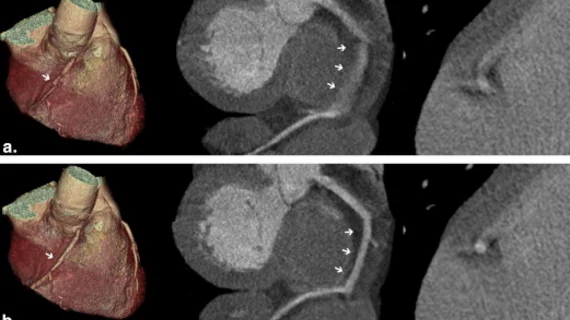Using coronary CT angiography (CCTA) to identify which patients with suspected coronary artery disease (CAD) really need invasive angiography can lower the overall cost of diagnostic testing without sacrificing safety, suggests a randomized trial published Dec. 12 in JACC: Cardiovascular Imaging.
The study from lead author Hyuk-Jae Chang, MD, PhD, and colleagues included more than 1,600 patients who were recommended for nonemergent invasive coronary angiography (ICA) based on American College of Cardiology/American Heart Association guidelines. About half of the patients were randomized to a direct referral strategy—that is, ICA right away—while the other half were put on a selective referral pathway. Those patients received CCTA first and then a physician decided whether to proceed with invasive angiography.
Importantly, the referral strategies were associated with equal rates of major adverse cardiovascular events (MACE) at one year of follow-up, at 4.6 percent. MACE included death, MI, unstable angina, stroke, urgent revascularization or cardiac hospitalization.
While all of the patients in the direct referral arm received ICA, 77 percent of patients who first received the noninvasive imaging test avoided ICA. Also, rates of PCI were lower in the selective referral group (11 percent versus 15 percent) but the downstream use of exercise electrocardiography testing was higher (14 percent versus 11 percent).
“Although higher rates of follow-up testing were reported in the selective referral arm, cumulative diagnostic test costs remained 57% lower in the selective referral arm, which was solely due to the higher upfront costs associated with ICA,” wrote Chang, with Yonsei University Health System in Seoul, South Korea, and coauthors.
The total diagnostic test cost averaged $1,183 for patients in the selective referral pathway and $2,755 for those sent straight to ICA. An initial CCTA cost $401 while the index ICA was $2,549.
One-quarter of patients who received an invasive angiography after a CCTA were found to have no obstructive CAD, but 61 percent of patients in the direct referral arm didn’t have obstructive disease—a sign that the test may often be unnecessary in patients with suspected CAD who nevertheless meet guideline-recommended criteria to receive ICA.
“In the selective referral strategy, the reduced use of ICA was associated with a greater diagnostic yield, which supported the usefulness of CCTA as an efficient and accurate method to guide decisions of ICA performance,” the authors wrote. “Because of the high rate of ICA across the United States, the implications of findings from the CONSERVE trial could expedite a patient’s diagnosis of CAD while providing for a prompt and efficient diagnostic pathway guided by CCTA findings.”
In a related editorial, David E. Newby, DM, with the University of Edinburgh in Scotland, noted cardiac hospitalizations accounted for a substantial proportion of the MACE endpoint, whereas the number of “harder” events like MI or death remained low. Because of this, it may have been difficult to detect meaningful differences in downstream event rates with only one year of follow-up, he said, making it important to follow this study cohort more in the future.
Nevertheless, Newby described Chang et al.’s work as “an important contribution to the field.”
“The CONSERVE trial addressed an important clinical question and lends further weight to the increasing use of CCTA as a first-line test of choice in patients being investigated for coronary heart disease,” Newby wrote. “It showed that even in those who are directly referred for invasive coronary angiography, CCTA is a noninferior alternative that reduces the need for invasive angiography, decreases invasive procedures, and appears to result in similar short-term clinical outcomes. So now, the question is why would you go straight for invasive coronary angiography?”

